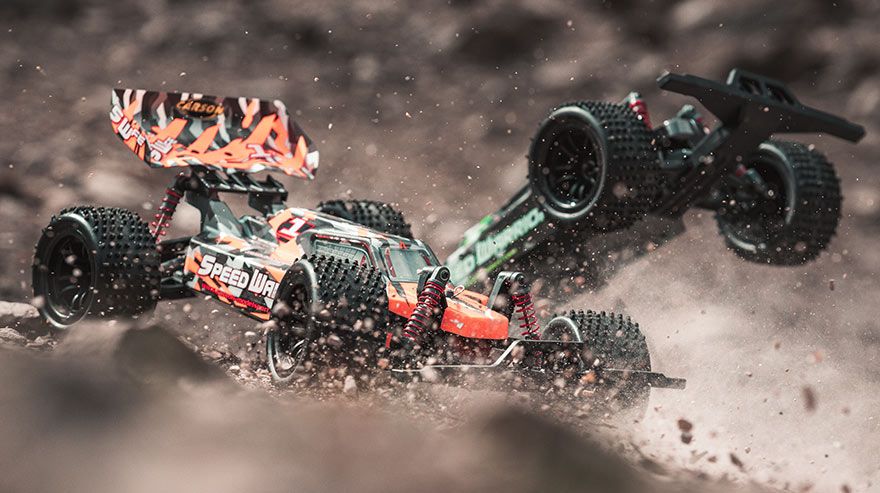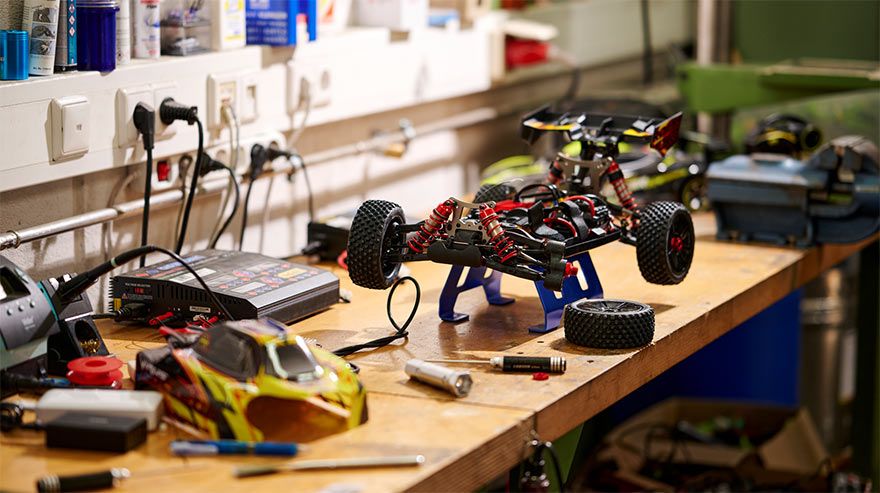Motorcycle models

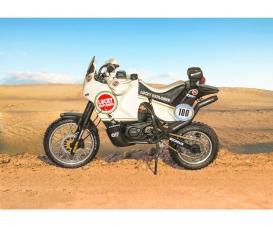
Motorcycle models
1:9 Cagiva Elephant 850 Winner 1987
510104643€64.99
Article number: 510104643 Product: 1:9 Cagiva Elephant 850 Winner 1987 Model Dim.: 23,8 cm COLOR INSTRUCTION SHEET - RUBBER PARTS - SCREWS, SPRINGS AND RUBBER TUBES The Cagiva Elefant was introduced in the early 1980s as an enduro motorcycle characterized by small to medium displacement engines. Following the acquisition of Ducati by Caviga, commercial production gradually evolved to incorporate the more powerful high performance twin-cylinder engine from 1985 onwards. The Cagiva Elefant competed against both German and Japanese motorcycles in the prestigious 1987 Paris-Dakar ‘off-road’ rally. The bike was characterized by its distinctive large fairing which covered the steel tube and light alloy trellis frame. The air-cooled twin-cylinder engine provided 80 HP at 8500 rpm and allowed the Italian bike to reach a maximum off-road speed of 185 km / h. The bike design reflected a "typical" Saharan configuration, with protective fairing, Ohlins off-road shock absorbers and low front fender. Detailed Plastic Kit

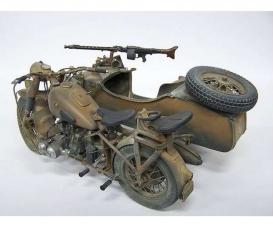
Motorcycle models
1:9 German Milit.Motorcycle w/sidecar
510007403€65.99
Article number: 510007403 Produkt: 1:9 BMW R75 German Milit.Motor.w/Sidecar Model Dim.: 26,7 cm In 1938, based on a specific request of the German army, BMW and Zundapp received the brief to start a co-joint development project able to guarantee the highest number of common components to optimize the maintenance activities and the spare parts logistic. The prototypes had been released on 1940 and the production started at the beginning of 1941. Its peculiar feature was to have the side-car wheel that was driven with an axle connected to the rear wheel of the motorcycle. These were fitted with a locking differential and selectable gear ratios to optimize the on-road / off-road performance. The twin-cylinder engine with a displacement of 750 cc was capable of delivering 26 HP. The BMW R75 was able to reach the max speed of 95 Km/h. It was widely used, proving its realiability and sturdiness, on all most important operating theaters and in all environmental conditions (from North Africa to Russia). Deatailed plastic kit of model BMW R75 German Milit. Motor. w/Sidecar in scale 1:9

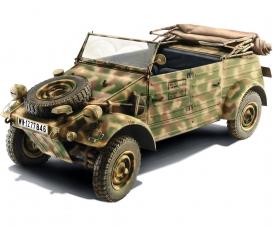
Motorcycle models
1:9 KDF. 1 Typ 82 Kübelwagen
510007405€104.99
Article number: 510007405 Product: 1:9 KDF. 1 Typ 82 Kübelwagen Mod.Dim.: 41,5 cm Working suspensions - Openable lid - Higly detailed engine - Higly deteiled decals sheet - Canvas roof and windows - Working canvas roof - Steering front axle - Rubber tires - Colors instructions sheet Typ 82 Kubelwagen is one of the most famous military cars of the Second World War. It was designed by the engineer Ferdinand Porsche and produced by the German manufacturer Volkswagen. The project was born to have a simple vehicle, easy to build and easy to maintain and repair. The overall vehicle design is without bends and the bodywork plates are flat. Great simplicity even in the layout of the frame : just a central tube and the back support for the engine and the gearbox. The Kubelwagen, thanks to its petrol engine with a displacement of 998 cm3, was able to reach the max speed of 80 Km/h. The vehicle did not have 4x4 traction but it was extremely reliable on all types of terrain and it was present on all fronts, often in very tough environmental conditions, where the German Army fought during the entire World War II. The Kubelwagen could be armed with a support for a MG34 or MG42 machine gun. Detailed Plastic Kit of model

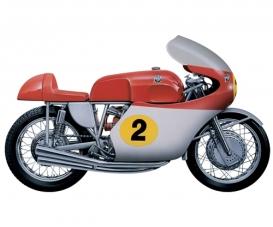
Motorcycle models
1:9 MV AGUSTA 1964 – 4 cylin. 500cc
510004630€51.99
Article number: 510004630 Product: 1/9 MV AGUSTA 1964 – 4 cylin. 500cc Model Dim.: 22,1 cm This Cardan-transmission motorcycle, first built in 1950, reached a peak of reliability and competitiveness in 1956 when it adopted chain transmission and a telescopic front fork. The 500 cc 4-cylinder MV Agusta was ridden by the worlds most famous racers - J. Surtees, M. Hailwood, G. Hocking and G. Agostini. Thanks to them this near-unbeatable motorcycle dominated the 500 cc category from 1956 to 1965, winning 9 world titles. It continued competing until 1966 when it was retired to make way for a new, lighter, more manageable 3-cylinder motorcycle. The model, pre-moulded in the original colours and with chrome-plated parts, also features working suspension and rubber tyres. Deatailed plastic kit of model MV AGUSTA 1964 – 4 cylinder 500cc in scale 1:24

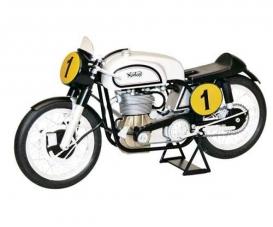
Motorcycle models
1:9 Norton Manx 500cc 1951
510004602€59.99
Article number: 510004602 Product: 1/9 Norton Manx 500cc 1951 Mod.Dim.: 22 cm This glorious English manufacturer made a comeback after the Second World War. In 1949 this famous single-cylinder 500, ridden by Daniell, won the first world championship race to be held in England, on the torturous Tourist Trophy circuit. In 1950 and 1951 it was ridden to world championship title victory by the fearless Englishman G. Duke. Innovative for its time, it was the first bike to use an upper and lower cradle-type chassis. Deatailed plastic kit of model Norton Manx 500cc 1951 in scale 1:24

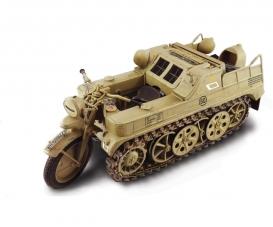
Motorcycle models
1:9 NSU HK 101 "Kettenkrad"
510007404€87.99
Article number: 510007404 Product: 1:9 NSU HK 101 "Kettenkrad" Model Dim.: 32,9 cm Working suspensions - Openable lids - Higly detailed engine - Higly deteiled decals sheet - Running tracks - Tool set At the beginning, Sd.Kfz 2 "Kettenkrad" was developed as light means of transport for airborne troops. It was a small vehicle with the front similar to a motorcycle, characterized by its handlebars and its central wheel and by a rear designed to Feature a 6 wheels tracked structure. The Kettenkrad could transport 2 passengers, additionally to the driver, or transport goods and ammunitions. It could reach a top speed of 70 km/h thanks to its OHV inline-four Opel water-cooling, the same featured on Opel Olympia car. Through its tow hook it was able to drag up to 450 kg of goods as antitank cannons of moderate size. The Kettenkrad resulted to be perfect in carrying loads and people on uneven grounds, as those sandy in North Africa or muddy ones is Russian Steppe. Later, since 1944 onwards, it was used on runways for handling of jet fighters Messerschmitt Me 262 and jet bombers Arado A-234. Deatailed plastic kit of model NSU HK 101 "Kettenkrad" in scale 1:9


Motorcycle models
1:9 Suzuki RG500 XR27 Team H.B.S.
510104644€69.99
Article number: 510104644 Product: 1:9 Suzuki RG500 XR27 Team H.B.S. 1978 The Suzuki RG 500 is considered to be an icon of two-wheel racing motorcycles of the 1970s. It was specifically developed by the Japanese manufacturer Suzuki for the racing world, and built around the reliable and powerful 4-cylinder 500cc 2-stroke engine which provided up to 90 HP. With this bike Suzuki participated in the world championships in the 500 class, achieving an incredible series of consecutive victories that led to it retaining the "constructors" title for several years. One of the architects of this successful period was the British rider Barry Sheene, who also won the "pilots" title for two consecutive years, in 1976 and 1977. In addition to international competitions, the Suzuki RG 500 was particularly appreciated by private riders who raced it in both international competitions and in minor leagues. Detailed plastic kit

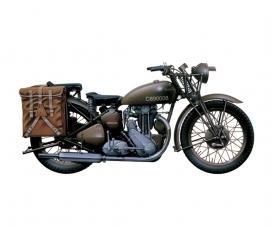
Motorcycle models
1:9 Triumph
510007402€41.99
Article number: 510007402 Product: 1/9 Triumph Model Dim.: 23,1 cm Decals for 4 versions. At the start of the 2nd WW, Great Britain did not have all the technical equipment needed for such a conflict, therefore a lot of vehicles were ordered urgently. Motorcycles, mainly used by the well known DR "Dispatch Riders" for communication between different units, were converted from civilian bikes with small changes, like military color and the addition of frames for the canvas bags. Triumph proposed in short time the model 3HW, based on the civilian "Tiger 80", with an overhead valve engine and parallel forks. This model served on all fronts where the British Armed Forces fought, such as Africa, Europe and Asia. After 2nd WW these motorcycles were delivered to many other nations, such as Italy and Greece, where the Triumphs served for a long time thanks to their reliability and robustness. Deatailed plastic kit of model Triumph in scale 1:9

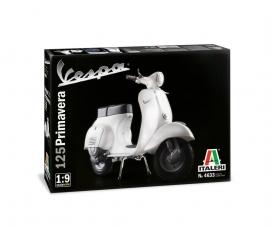
Motorcycle models
1:9 Vespa 125 "Primavera"
510104633€49.99
Article number: 510104633 Product: 1:9 Vespa 125 "Primavera" Length of the model 200 mm UPGRADED PARTS Vespa is an icon of design and style of the "made in Italy" and a real myth on two wheels. The first Vespa was born in the second post-war period, in 1946, and was immediately characterized by simple and elegant lines, and by a practical, functional and reliable project developed around the famous steel body-frame. The effective mix of design and functionality was the strength of the Vespa, that became, in a short time, an extraordinary commercial success worldwide. During the years Vespa was able to keep its uniqueness but improved in style and features. One of the most famous versions was the Vespa Primavera 125 launched in 1968. Thanks to an improved engine, a better performance and an easiness of driving, it remained on the market throughout the 1970s. The Primavera 125 is still today one of the most preferred Vespa by collectors and fans of the famous Italian two-wheeler manufacturer Deatiled static model kit

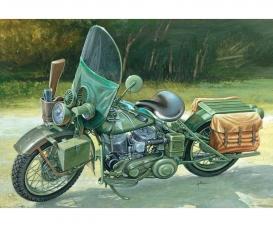
Motorcycle models
1:9 WLA 750 US Military Motorcycles
510007401€51.99
Article number: 510007401 Product: 1/9 WLA 750 US Military Motorcycles Mod.Dim.: 27,7 cm This impressive motorcycle, built in the late 30s to the requirements of the American Police forces, and, in limited quantities, for the civil market, was used during the 2nd World War also by the American armed forces. Very sturdy and reliable, this motorbike was used by the military Police for surveillance, and by couriers for rapid delivery of messages between front line units, thanks to its good road-holding and the performance of its powerful engine. Detailed Plastic Kit of model WLA 750 US Military Motorcycles in scale 1:9














